Russian Current
Table of Contents
What is a Russian Current?
It is also called as Tone Burst current. It was first investigated by Dr. Y M Kots in Russian literature. It provoked much interest because the successful Olympic team was using it in addition to their usual training program.
It was suggested that its use significantly increased muscle strength (about 30 – 40 %). In 1970 claims were published that this 2500 Hz medium frequency interrupted current (Russian current) could produce to generate greater muscle force (contraction) than a maximal voluntary contraction.
Although it is a medium-frequency current the nerves are stimulated because it is interrupted to give a low-frequency stimulation of 50 Hz. Russian current consists of 2500 Hz frequency evenly alternating medium frequency current applied as a series of separate bursts having a pulse duration of 0.2 ms (200 µs) which is interspersed (interrupted) with 10 ms (1000 µs) when no current flows producing 50 bursts per second (50 Hz) which is in fact like the low-frequency faradic type of current.
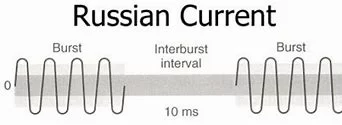
The theoretical basis for the use of this current is that maximal electrical stimulation of nearly all motor units in a muscle to contract something that can not be obtained in voluntary contraction. This produces greater muscle contraction and hence produces hypertrophy.
Introduction
- 1977 yakov kots( Russian physiologist )
- it is basically medium frequency current
- it is intermittant alternating sinusodiul current with carrier frequency 2500 hz
- Russian current sinusoidal waveform, delivered in bursts or series of pulses
- hence it is known as medium frequency burts alternating current
- carrier: frequency 2500 hz
- waveform: polyphasic sinusoidal waveform
- current amplitude: the maximum amplitude 100 ma but the clinical base 70 ma
- blurts frequency: 50 hz
- burst duration: 10 ms
Characteristics
- on/off ratio: the on/off ratio is defined as the ratio of the time during which there is stimulation( contraction ) to the time during which there is no stimulation ( no contraction ) set as 10ms:10ms.
- duty cycle: duty cycle is the proportion of on time to the summation of both the on and off time expressed as a percentage.
- ramp-up and down: setting the ramp time is very important to evoke contraction similar to muscle contraction. as the ramp allows a gradual increase of intensity with the associated gradual increase of muscle contraction. set for 1-2 seconds
- training protocol with Russian current:
clinical protocol – 1) 10=muscle contraction, lasting for 10 seconds - 2) 50 off time no contraction for 50 seconds
- 3) 10 cycles repeated for 10 min
duration and frequency of treatment: the recommended duration of treatment is 10 minutes, once daily per week for several weeks ( 3 months )
electrodes placement: arranged parallel to the direction of muscles fibers so that it is at the estimated line of pull of the muscles.
time delay switch: synchronous mode ( both channels triggered simultaneously. achieved by not setting time delay). reciprocol mode ( channels 1 is on then 2 is off- achieved by setting time delay equal to time of channel 1 ). overlapping mode ( channel 2 overlaps with on time and off time of channel 1- achived by setting time delay more then 1 sec but less than on time of channel 1).
Physiological effects
depends on:
- the total number of burts delivered per second
- russian current has a capacity to depolarized:
1 sensory nerve fibers – moderate prickling sensation
2 motor nerve fibers – tetanic muscle contraction
- allow use of high amplitude contraction stronger than those generated by voluntary control ( voluntary contraction- motor units recruited asynchronously while in electrically evoked muscle contraction- motor units fire synchronously).
- this contraction is painless due to sensory nerve blocked of pain gate
Physiological effects
- medium frequency modulated sinusoidal currents
- depolarization of sensory and motor nerve fibers. synchronously, motor nerve depolarization induce activation of fast type 2 motor units
- high level electrically evoked muscular contraction
- contraction against external load
- muscle strengthening
Therapeutic effects/ protocol
1) To improve muscle strength
amplitude: tetanic muscle contraction
pulse rat (burst frequency): 150-200
apply current during volitional: isometric in different ROM slow speed isokinetic and short arc movement
2) to reduce muscle spasm
amplitude: tetanic muscle contraction up to patient tolerance
pulse rate : 50-175
stimulation is applied to provide brief isometric contraction
on time 5-12, off time 8-15 secs
3) to reduce oedema ( due to lack of muscle contraction )
amplitude: small visible muscle contraction
pulse rate: 35-50
pulse duration: around 400
on time 1-2 secs off time 1-2 secs promote muscle pumping
treatment time 10-15 min.
Protocols for Russian current:
- Protocol for muscle strengthening/ hypertrophy:
Amplitude/ Intensity:
-Tetanic contraction
Pulse rate:
-50 – 70 Hz
Pulse duration:
-150 – 200 µs
Apply current during volitional activities (voluntary activities)
Isometric exercises at several points through a range of motion.
Slow isokinetic (movements in the same direction) exercises 5 – 10° per second.
Short arc joint movement when ROM is restricted.
Protocol for muscle spasm reduction:
Amplitude:
- Tetanic contraction depending upon patient toleran
pulse rate
- 50 – 70 Hz
Pulse duration:
- 50 – 175 µs
Muscle contraction isometric
INDICATION
- the only indication for use of russian current as introduced by kots in 1977, is to strengthen the muscular system of healthy and athletic persons.
- post knee ligaments surgery
- post arthroscopic knee surgery
- following ligament sprain
- post casting
- muscle spasm
Contraindication
- Cardiac pacemakers and Arrhythmias
- Hemorrhagic condition
- Thrombosis and thrombophlebitis (inflammation of the wall of a vein)
- Early tendon transfer and repair
- Pregnancy: On pelvic, low back, and abdomen
- Unconscious patient
- Recent radiotherapy
- Carotid sinus
- A child with mental disturbance
- Malignancy
FAQs
designed to quicken muscle recovery, build larger, more resilient muscles, and strengthen existing muscles. Uses high frequency, sinusoidal stimulation waveforms, similar to EMS.
This could be explained by the fact that the Russian current causes almost all of the muscle’s motor units to contract simultaneously, increasing muscular growth.
Six The most direct physiological response for HVPGC is the electrochemical changes that take place at the cellular and tissue levels. Russian current has the greatest physiological effect at the cellular level8. Additionally, the stimulus-rest ratios at which these two currents are administered are typically different.
With a pulse length of 0.4 ms (400 us), a carrier frequency of 2500 Hz, a modulation frequency of 50 Hz, and a duty cycle of 50%, the classical Russian current exhibits a sinusoidal waveform. (10 emission, 10 pause milliseconds)
One of the earliest advocates of employing EMS in sports was the Soviet scientist Dr. Yakov Kots, who wanted to improve the fitness levels of USSR Olympic participants during the games. In his EMS application, which came to be known as the Russian Stim or Kots Current, Kots employed a frequency of 2500 MHz.


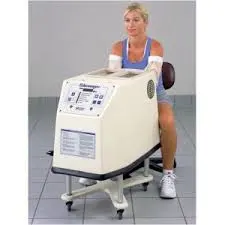
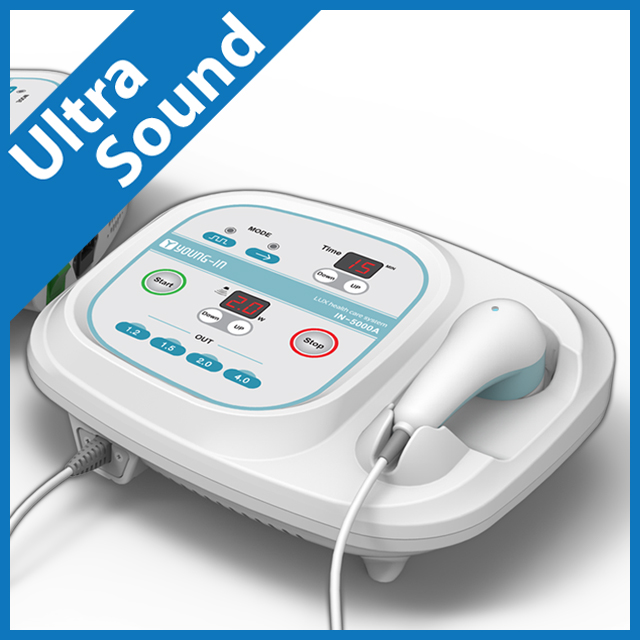

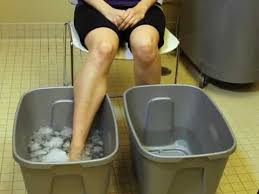
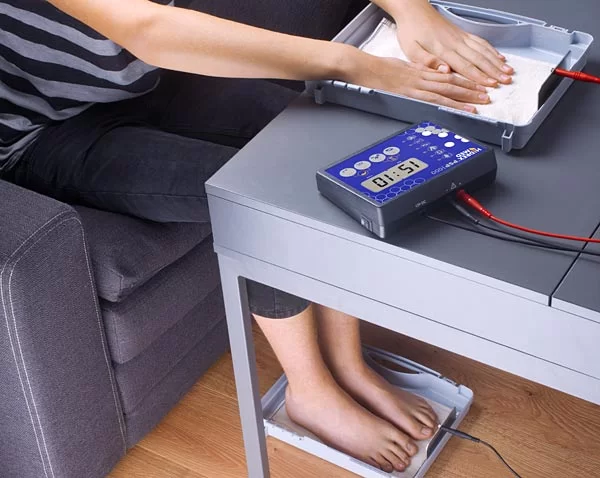
Russian current use in physiotherapy clinic Ahmedabad